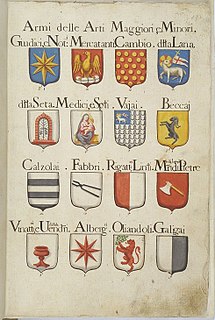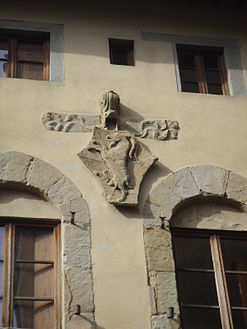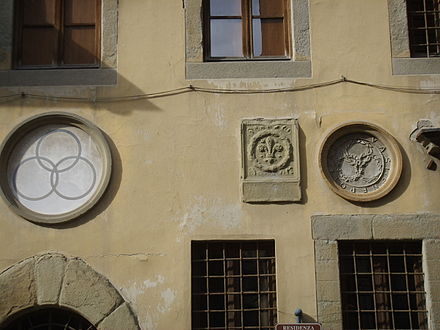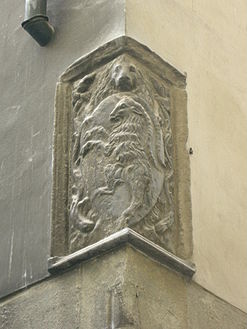
The Accademia di Belle Arti di Firenze is an instructional art academy in Florence, in Tuscany, in central Italy.

The Arte della Lana was the wool guild of Florence during the Late Middle Ages and in the Renaissance. It was one of the seven Arti Maggiori ("greater trades") of Florence, separate from the Arti Minori and the Arti Mediane (the "middle trades"). The Arte della Lana dealt in woollen cloth and cooperated with the other corporations of bankers and merchants in administering the commune, both under the podestà and the Republic of Florence.

Bernardino Poccetti, also known as Barbatelli, was an Italian Mannerist painter and printmaker of etchings.

The Accademia di Belle Arti di Bologna is a public tertiary academy of fine art in Bologna, in Emilia-Romagna in northern Italy. It has a campus in Cesena.

The guilds of Florence were secular corporations that controlled the arts and trades in Florence from the twelfth into the sixteenth century. These Arti included seven major guilds, five middle guilds and nine minor guilds. Their rigorous quality control and the political role in the commune that the Arti Maggiori assumed were formative influences in the history of Florence, which became one of the richest cities of late Medieval Europe.

The Accademia delle Arti del Disegno, or "Academy of the Arts of Drawing", is an academy of artists in Florence, Italy. The Accademia e Compagnia delle Arti del Disegno, or "academy and company of the arts of drawing", was founded on 13 January 1563 by Cosimo I de' Medici, under the influence of Giorgio Vasari. It was made up of two parts: the Company was a kind of guild for all working artists, while the Academy was for more eminent artistic personalities of Cosimo’s court, and supervised artistic production in Tuscany. It was later called the Accademia delle Arti del Disegno.
Accademia Fiorentina or Florentine Academy may refer to:
Academy of Florence or Accademia di Firenze may refer to:
Accademia often refers to:

The Accademia di Belle Arti di Napoli is a university-level art school in Naples. In the past it has been known as the Reale Istituto di Belle Arti and the Reale Accademia di Belle Arti. Founded by King Charles VII of Naples in 1752, it is one of the oldest art schools in Italy, and offers various levels of study up to and including the equivalent of an Italian laurea. It is located one block south of the church of Santa Maria di Costantinopoli, on the via of the latter church's name.

The Accademia di Belle Arti di Perugia is a private tertiary academy of art in Perugia, in Umbria in central Italy. It is not one of the 20 official Italian state academies of fine art, but is legally recognised by the Ministero dell'Istruzione, dell'Università e della Ricerca, the Italian ministry of education and research, which gives its full name as Accademia di Belle Arti Legalmente Riconosciuta di Perugia "Pietro Vannucci". The academy became an autonomous degree-awarding institution under law no. 508 dated 21 December 1999.

Enrico Crispolti was an Italian art critic, curator and art historian. From 1984 to 2005 he was professor of history of contemporary art at the Università degli Studi di Siena, and director of the school of specialisation in art history. He previously taught at the Accademia di Belle Arti in Rome (1966–1973) and at the Università degli Studi di Salerno (1973–1984). He was author of the catalogues raisonnés of the works of Enrico Baj, Lucio Fontana and Renato Guttuso. He died in Rome on 8 December 2018.

Claudio Kevo Cavallini was an Italian sculptor. His nickname was "Kevo" with which he signed his works. At the age of 50, Claudio discovered that he could make sculptural forms from wood.
Ugo Capocchini was an Italian artist. He won many awards throughout his career, and became a Professor at the Accademia Di Belle Arti in Florence in the 1960s. In his birthplace, Barberino Val d'Elsa, a square and a community hall have been named after him.
Saint George Freeing the Princess is a marble stiacciato bas-relief sculpture by Donatello, sculpted around 1416 or 1417. It was originally situated under the same artist's Saint George on an external niche of the church of Orsanmichele in Florence; both works are now in the Bargello Museum, with replicas replacing them in their original positions.

Four Crowned Martyrs is a sculptural group by Nanni di Banco. It forms part of a cycle of fourteen sculptures commissioned by the guilds of Florence for external niches of Orsanmichele, each sculpture showing that guild's patron saint. This sculpture was commissioned by the Arte dei Maestri di Pietra e Legname and completed around 1416-1417. It is in Apuan marble and is made of four figures of the Four Crowned Martyrs, the tallest of which is 2.03 m high. It is now indoors in the Museo di Orsanmichele, although a copy fills its original niche.

Saint Luke is a 2.73 m high bronze statue of Luke the Evangelist by Giambologna, commissioned by the Arte dei Giudici e Notai and completed in 1597–1602. One of a cycle of fourteen commissioned by the guilds of Florence for the external niches of Orsanmichele, it is now in the Museo di Orsanmichele, although a replica fills its original niche.
Saint Peter is a Apuan marble sculpture of Saint Peter of 2.43 m high. It is attributed to Filippo Brunelleschi and his style is influenced by Donatello. It forms part of a cycle of fourteen statues of the patron saints of the guilds of Florence for the external niches of Orsanmichele. The sculpture of St Peter was completed for the Arte dei Beccai (butchers) guild around 1412 and is now in the Museo di Orsanmichele, although a replica fills its original niche.

The Boldrone Shrine is located at the corner of the Via di Boldrone and the Via dell'Osservatorio in the Quarto district of Florence. It was named after the monastery of San Giovanni Evangelista di Boldrone, which was itself named after the French "Boldrone" hermitage founded on that site in the 13th century.


















